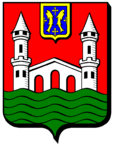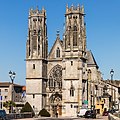Pont-à-Mousson
| Pont-à-Mousson | ||
|---|---|---|

|
|
|
| region | Grand Est | |
| Department | Meurthe-et-Moselle | |
| Arrondissement | Nancy | |
| Canton | Pont-à-Mousson (main town) | |
| Community association | Bassin de Pont-à-Mousson | |
| Coordinates | 48 ° 54 ' N , 6 ° 3' E | |
| height | 172-382 m | |
| surface | 21.60 km 2 | |
| Residents | 14,228 (January 1, 2017) | |
| Population density | 659 inhabitants / km 2 | |
| Post Code | 54700 | |
| INSEE code | 54431 | |
| Website | www.ville-pont-a-mousson.fr | |
 Town hall Pont-à-Mousson on Place Duroc |
||
Pont-à-Mousson (German outdated also Mussenbrück ) is a French commune with 14,228 inhabitants (as of January 1, 2017) in the Meurthe-et-Moselle department in the Grand Est region ( Lorraine until 2015 ). It belongs to the Arrondissement of Nancy , is the capital of the canton of Pont-à-Mousson and the seat of the Bassin de Pont-à-Mousson municipal association . The city's residents are called Mussipontains in French .
geography
The city lies on both sides of the Moselle , about halfway between Metz and Nancy . Due to its strategic location, it was bombed several times during both world wars. The priest forest, which was fiercely contested in the First World War, is to the northwest of the village .
history
Pont-à-Mousson got its name from the Moselle bridge ( French pont ), which has existed since the 9th century, of the municipality of Mousson located on a mountain spur above the Moselle .
The Jesuit Academy of Nancy was founded by the Dukes of Lorraine in Pont-à-Mousson on December 5, 1572 , and moved to Nancy in 1769 (now the University of Nancy ).
Population development
| year | 1962 | 1968 | 1975 | 1982 | 1990 | 1999 | 2007 | 2017 |
| Residents | 12,802 | 13,406 | 14,830 | 14,942 | 14,645 | 14,592 | 14,065 | 14,228 |
Attractions
Pont-à-Mousson has numerous architectural monuments and the menhir la Pierre au Jô , all of which are protected as Monument historique .
The former Premonstratensian Abbey is located directly on the banks of the Moselle . Since 1964, the large monastery complex has been a cultural center and the seat of the European Center for Sacred Art.
In the buildings of the former Jesuit college with the church of St-Martin , the university was located for two centuries, which was then moved to Nancy . The buildings were temporarily used by the Royal Military School; today there is a high school here.
The building of the Hôtel de ville was built by the architect Claude Mique between 1786 and 1791 according to plans by the architect François-Michel Lecreulx. In the 19th century , people began to use it as a city hall. Despite major destruction and renovations, some original components still exist, such as the peristyle from the 18th century including the wrought iron grating and gates, the grand salon on the first floor with plaster in neoclassical style, the council chamber decorated with wood paneling, the staircase and the Salon Mique .
A modern chapel was built on the Butte de Mousson , at the foot of which the city lies, which can be seen from the Moselle.
The former synagogue (Monument historique) is now used as a residential building.
economy
There is heavy industry in the area. The ironworks S.A. founded in 1856 des Hauts-Fourneaux et Fonderies de Pont-à-Mousson , to which the Halbergerhütte had belonged since 1919 , merged with the Compagnie de Saint-Gobain in 1970 .
Town twinning
Personalities
- Guarinus von Sitten (1065–1150), bishop and saint
- Géraud-Christophe-Michel Duroc (1772–1813), general and diplomat, since 1804 Grand Maréchal du Palais
- Charles Nicolas Fabvier (1783–1855), French general
- Pierre Lallement (1843-1891), inventor
Web links
- City website (French)
- La caserne Duroc at http://frizbee.free.fr/ with historical views






